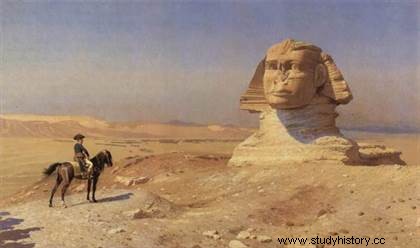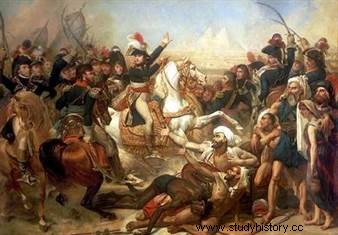 Won by Bonaparte over the Mamluks of Egypt on July 21, 1798, the Battle of the Pyramids is the most prestigious (and rare) French victory of the Egyptian campaign. She will leave to posterity one of the most famous quotes of the future emperor:“From the top of these pyramids forty centuries of history contemplate you! »… In the footsteps of Caesar and Alexander, the young general launched the armies of the Republic on a wild military and scientific adventure in the land of the Pharaohs, occupied by the legendary Mamluks… At the gates of Cairo, their mythical cavalry, reputed to be the best in the world, was overwhelmed by the infantry of the French expeditionary force. Story of an "Egyptian Agincourt" at the foot of the thousand-year-old pyramids.
Won by Bonaparte over the Mamluks of Egypt on July 21, 1798, the Battle of the Pyramids is the most prestigious (and rare) French victory of the Egyptian campaign. She will leave to posterity one of the most famous quotes of the future emperor:“From the top of these pyramids forty centuries of history contemplate you! »… In the footsteps of Caesar and Alexander, the young general launched the armies of the Republic on a wild military and scientific adventure in the land of the Pharaohs, occupied by the legendary Mamluks… At the gates of Cairo, their mythical cavalry, reputed to be the best in the world, was overwhelmed by the infantry of the French expeditionary force. Story of an "Egyptian Agincourt" at the foot of the thousand-year-old pyramids.
Crossing the Desert
Thwarting the vigilance of the English navy, the French expeditionary force of the Egyptian campaign seized Alexandria on July 2, 1798. Positioning itself as a liberator of Egypt driving out the tyrannical Mamluks with the blessing of the Sublime Porte, General Napoleon Bonaparte actually seeks to found the first colony of the French Republic. A colony whose scientists are responsible for creating the first social, agricultural and industrial structures for long-term exploitation.
It must also make it possible to cut off a major trade route from the English and serve as a starting point for a great expedition to the Far East, to India, where the the hereditary enemy would be fought alongside Maharajah Tippoo Sahib. Hoping for the passivity of the Ottoman Empire in the face of a fait accompli, Bonaparte wanted to take by surprise the 10,000 Mamluks who held the country under the command of about twenty Beys.
Bonaparte has 40,000 men, morale is not good for the French soldiers who, instead of Eden, find a poor and starving country where the majority of the population is composed only of poor wretches devoured by vermin. Bonaparte therefore wanted to play at speed, to surprise his enemy and comfort his army in the euphoria of victory. The temperature reaches 50°C in the shade, thick Western uniforms are not suitable for this stifling climate. The wisest, most reasonable path is the sacred river of Egypt, the Nile, miraculous serpent of life in the midst of this arid land. But it is also the most predictable path, the one where he will be expected, and Bonaparte decides to circumvent any possible defense device by cutting directly through the desert, leaving only a flotilla to descend the river from Rosette to join the army in Ramanieh.
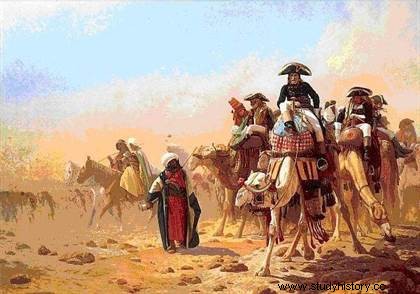 The Desaix division set out in the vanguard, followed by the Reynier divisions , Dugua , Good and Vial . A week of crossing the desert, a week of incredible suffering under a blazing sun. There is no water, the wells are stoned or filled with salty earth, the cisterns found along the way are empty or poisoned, people dig in them to find the source. The soldiers hurry and crash for a sip of water, the rear guard led by Bon is ordered to serve with a teaspoon!
The Desaix division set out in the vanguard, followed by the Reynier divisions , Dugua , Good and Vial . A week of crossing the desert, a week of incredible suffering under a blazing sun. There is no water, the wells are stoned or filled with salty earth, the cisterns found along the way are empty or poisoned, people dig in them to find the source. The soldiers hurry and crash for a sip of water, the rear guard led by Bon is ordered to serve with a teaspoon!
Food is also lacking, the miserable shacks encountered do not offer the necessary supplies, without mills or ovens the army is unable to take advantage of the few fields of wheat. The most far-sighted keep a few melons picked before departure, and especially some broad beans.
The quartermasters are sent to buy food in the rare villages encountered, but the hostile and destitute population has most often fled. At Damanhour, the quartermasters of the Reynier division are greeted with gunfire, the fight begins and the resistance fighters are shot. The desert expanses melt the workforce, disappointed, exhausted, baffled by mirages, suffering from ophthalmia, overwhelmed by the heat and deprivation, the men come to commit suicide, to stay behind... Around the Bedouins, predators around a herd, unable to attack head-on, waiting for a weakened element to break away from the group...
The unfortunates who fell into their hands are abused, slashed, raped, often only bloody bodies are found from them. The climate is one of revolt, the veterans of the Army of the Rhine do not have the respect of those of the Army of Italy for the general in chief. The generals themselves doubt, lose their temper, trample their hats. Desaix said bluntly to Bonaparte:"If the army does not cross the desert with the speed of lightning, it will perish". On the map, the route is only a hundred kilometers, but the conditions are extreme, we quickly decide to walk at night.
Chebreiss, the prelude to the Battle of the Pyramids
At the end of the journey, the joy of the soldiers at the sight of the Nile is equaled only by that of the Hebrews discovering the divine manna, the ½ brigades disband, all throw themselves in the river, a field of watermelons consecrates this long-awaited moment. But already some Mamluks are approaching 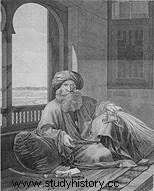 nt, they are chased away with gunfire. July 10 Mourad Bey sends a flotilla and 4,000 cavalry to meet the French, the clash takes place at Chebreiss where the square formation by division is inaugurated:these squares are in fact rectangles, formed of six rows of infantrymen on the long sides, three rows on the small ones, cannons loaded with grapeshot at the corners, cavalry, civilians and protected baggage in the center.
nt, they are chased away with gunfire. July 10 Mourad Bey sends a flotilla and 4,000 cavalry to meet the French, the clash takes place at Chebreiss where the square formation by division is inaugurated:these squares are in fact rectangles, formed of six rows of infantrymen on the long sides, three rows on the small ones, cannons loaded with grapeshot at the corners, cavalry, civilians and protected baggage in the center.
The Mamluks have blind faith in their cavalry, reputed to be the best in the world. Sinful by excess of confidence, they look with contempt on this invader whom they think will trample on the first charge. A Circassian slave trained in warfare from an early age, the Mamluk horseman is an overarmed warrior who, carrying all his wealth in his holsters, is all the more ardent in defending his property.
Readyed on all sides, launching beastly howls, the frenzied charge is enough to impress ordinary mortals. But the French infantrymen are for the most part no longer impressionable young people, and these veterans of the Rhine or of Italy wait impassively for the order to fire the murderous salvo. At the Battle of Chebreiss , the Mamluks counterattack was stopped dead by the discipline of the French soldiers. They fell back leaving on the burning sand 300 cavalry, 400 to 500 infantry and 9 iron artillery pieces.
On the river the fight is fierce, the French fleet is approached by Egyptian ships. The sailors, the dismounted riders who were on board but also the civilians on board (Monge, Berthollet, etc.) showed bravery and repelled the attackers. The Egyptian fleet retreats, while the current carries the remains of a gunboat.
"From the top of these pyramids, forty centuries are watching you! »
The Beys aren't so much calmer by this defeat, they continue to talk, no real reconnaissance is carried out, they still don't know where the enemy came from. Although certain of Bonaparte's presence on the left bank of the Nile, they did not take the necessary measures to defend Cairo:their army could have entrenched themselves on the right bank and waited patiently for a landing that they could repel at any point. thanks to the mobility of his cavalry. Instead Mourad Bey settles on the left bank while Ibrahim Bey remains on the right bank in case a French army could land on the other bank.
After giving his troops a little rest Bonaparte resumes his inexorable march towards Cairo, the army drags through the burning sand dunes, still harassed by the Bedouins . On July 19, the village of Abou-Nichoubi opposes fierce resistance to the French avant-garde, the repression is ruthless, the civilians shot and the houses burned. This bloodthirsty example rallies some of the surrounding sheiks. The divisions remain in sight of each other, on July 20 the pyramids take shape on the horizon.
Warned by spies of the isolation of Mourad's army on the left bank the attack is decided, at two o'clock in the morning the army sets off and 24km course to arrive in contact with the enemy in the early afternoon of July 21, 1798. There Bonaparte launched his famous proclamation (perhaps retouched afterwards):
“Bonaparte, member of the Institute, general-in-chief.
Soldiers!
You have come to these lands to rescue them from barbarism, bring civilization to the Orient and rescue these beautiful regions from the yoke of England. Think that from the top of these pyramids, forty centuries contemplate you! »
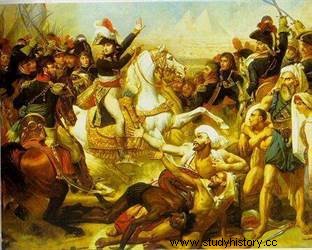 The Bey, with women, wealth and slaves, entrenched himself with 6,000 men, fellahs, Nubians and Janissaries , in the village of Embabeh, on the banks of the Nile, where Ibrahim's boats and galleys sail. Along the river are positioned the Mamluk cavalry and about 20,000 irregulars. The latter, simple populace armed with sticks and clubs have only a low military value, but the goal is to mass. Without tents to sleep in or organized supplies, they are most often forced to return home in the evening.
The Bey, with women, wealth and slaves, entrenched himself with 6,000 men, fellahs, Nubians and Janissaries , in the village of Embabeh, on the banks of the Nile, where Ibrahim's boats and galleys sail. Along the river are positioned the Mamluk cavalry and about 20,000 irregulars. The latter, simple populace armed with sticks and clubs have only a low military value, but the goal is to mass. Without tents to sleep in or organized supplies, they are most often forced to return home in the evening.
Bonaparte put his divisions into a square and advanced them to the heights of Waraq-el-Hader (2km from the enemy camp), Mamluk horsemen retreated as they went. As the army advanced, the right wing commanded by Desaix rested on the village of Biktil, which it passed. The village offering some resources and a formidable defensive positions Reynier and Desaix positioned grenadiers, dismounted dragoons, line and light infantry as well as an artillery company there.
Forming a curved line the French divisions (Desaix, Reynier, Dugua, Vial and Bon) extend from the pyramids to the Nile on which Bon's division is based. Thus positioned the rest is ordered and the men scatter to eat, drink... Suddenly multicolored dots are agitated on the horizon.
Preparations for the battle
The Mamluks, feeling threatened with encirclement by the advancing right wing, moved into position. Hastily the French join the ranks, reform the squares, and prepare to receive the best cavalry in the world. The first rank points with bayonets at mid-height, the second and third rank are shoulder weapons, ready to fire, the last three stand in reserve. After a salvo of artillery the Mamluks rush forward in a tumult of hooves striking the ground, a cloud of dust in the middle of which the golden harnesses throw lightning...
The French soldiers remain impassive, shoulder to shoulder. Despite a violent headwind, this torrent, half human nor animal, throws itself furiously on the Reynier and Desaix divisions, launching wild howls. At half a range the French officers give the order to fire, the murderous salvo cuts down the first rank which collapses in the whinnying of the horses and the cries of the wounded trampled by their compatriots. A second discharge strikes down the riders in a cloud of smoke. The charge shot at point-blank range aborted a few steps from the French squares, the horsemen turned back, the most fanatical came desperately to impale themselves on the wall of bayonets.
Some wounded find the strength to crawl to the French ranks and try to cut the knees of the infantry with their 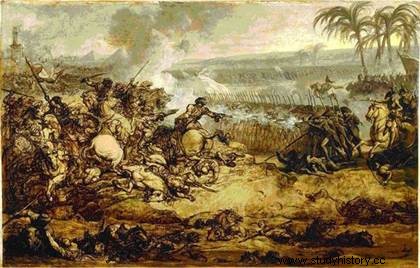 scimitars, they are larded with a thousand blows. The riders spin, enraged, to turn the position they rush between Desaix and Reynier and are caught in the crossfire. Unfortunately the squares are not staggered enough, the fratricidal fires make about twenty victims. In five minutes 300 cavalry were killed, about twice as many wounded, panicked part of the Mamluks left the battle. The others launch themselves against the village of Biktil where they are repulsed by the French entrenched on the roofs and in the gardens.
scimitars, they are larded with a thousand blows. The riders spin, enraged, to turn the position they rush between Desaix and Reynier and are caught in the crossfire. Unfortunately the squares are not staggered enough, the fratricidal fires make about twenty victims. In five minutes 300 cavalry were killed, about twice as many wounded, panicked part of the Mamluks left the battle. The others launch themselves against the village of Biktil where they are repulsed by the French entrenched on the roofs and in the gardens.
A few soldiers dispatched to fetch water in a small nearby village hasten to join the squares. A dragon is overtaken by a Mamluk horseman and an epic duel begins, for a moment the army holds its breath. Captain François says:
“As the Mamluks were charging towards the village of Belbeis, several soldiers escaped and joined their divisions. A dragoon of the 15th regiment was attacked by a dismounted mamluk; a struggle broke out between them, in the center of the Desaix and Reynier divisions. These two generals put an end to the fire on the side where the two adversaries were engaged. Finally, the dragon killed the mamluk and returned to the square; he had taken his enemy's saber, a saber with a solid silver scabbard, his dagger and his pistol. »
The Battle of the Pyramids
In twenty minutes of battle the cavalry dispersed, some horsemen took refuge in a park planted with palm trees, to the west, from where they were dislodged by skirmishers. The others join the camp, sowing panic in Embabeh where the Cairenes rush into the boats to save their lives. While the soldiers of Desaix and Reynier, who have suffered the brunt of the charge, rush to strip them to recover equipment and treasures left in the holsters and belts.
Bonaparte, galloping from one square to another, advances the Dugua division to come between the Mamluks and Embabeh and orders Bon and Vial to seize this village. Forming into a column, two detachments mounted an assault, taking advantage of a ditch that protected them from enemy artillery. Vial bypasses the village to the west while Bon sends Marmont and Rampon on the attack. The flankers who started in the lead are charged in turn, forming the square they machine-gun the Mamluks at full doublet, so close that the gunpowder ignites the tunics which continue to burn on the corpses.
The defenders fire their bad artillery and don't have time to reload as the French swoop down on them. The Cairenes have dispersed, there are only about 1,500 Mamluks who are killed or thrown into the Nile. Pursuing the fugitives, the attackers take the village. The hunted Egyptians run along the Nile until a wall forces them to throw themselves shovels into the river...
Before Ibrahim's reinforcements can land the rout is complete. Many fugitives drowned in the sacred river, such as Ibrahim's son-in-law whom an oarsman exasperated by the disaster struck repeatedly to kill him. Some sailors approach their ships so as not to leave them in the hands of the French, Mourad's ship, filled with gunpowder, runs aground and is set on fire. Meanwhile the Desaix division has resumed its march towards the Giza plateau, pushing the last warriors of Mourad Bey in front of it.
In this memorable battle, which will become a milestone in the Napoleonic epic, the French had 300 killed and wounded. For their part, the Mamluks had between 1,500 and 2,000 killed and wounded, lost 20 cannons, 400 dromedaries and all the baggage of the Mourad camp. The latter, wounded, fled to Upper Egypt while Ibrahim Bey rushed towards Syria. Bonaparte announces that he has crushed the bulk of the Mamluk forces, which must be put into perspective since the latter usually fled when they understood the impossible victory.
However, the general-in-chief can now return to Cairo deserted by his elites and proclaim Egypt liberated. In fact he has just won all of Lower Egypt and regained the confidence of his army. Enriched by the booty, finally bivouacking on the fertile banks of the Nile, the French savor their victory over this exotic enemy of incomparable bravery. Shock of cultures, infantry maneuvers overcame the most violent charges. Disconcerted, the Egyptians remain convinced that to have such a countenance the French soldiers had been tied together in the squares.
The Cairenes who had fled, looted by the Bedouins and somewhat reassured by the behavior of the victor, gradually resign themselves to returning to the Egyptian capital.
Although the battle takes place at Embabeh, Bonaparte rightly thinks that it will mark the opinion better, and his personal glory by associating it with the pyramids, symbols of the Pharaonic Egypt.
Bibliography and sources
- Garnier (Jacques), Atlas Napoleon, Napoleon I Editions, 2006.
- Joffrin (Laurent), Napoleon's battles, Editions du Seuil, 2000.
- Laurens (Henry), The Egyptian Expedition 1798-1801, Editions du Seuil, 1997.
- Pigeard (Alain), Dictionary of Napoleon's battles, Napoleonic Library, Tallandier editions, 2004.

